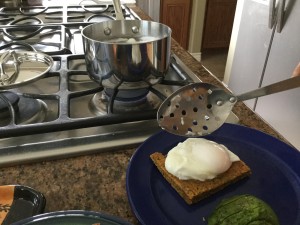It never fails to surprise me when someone asks me what a poached egg is. I’ve been eating them since I was a wee thing, and they’re easy to make. Bonus: it’s very simple to get the hardness exactly as you like. For me, that’s a big deal. I love the tenderness of a perfectly poached egg with delicious runny yolks, that I can smear all over my toast. If you like your eggs harder, that’s fine! Cook them longer. But this method will get you a perfect poached egg or two. Or more, if you use a bigger pot.
You need more width than depth in this case. This is my smallest saucepan and it’s just right for making two eggs. For three or more eggs, just get a bigger saucepan, but try to keep it shallow. You don’t need more than about three inches of water in the pan. I don’t use my cast-iron skillets for this, but a deep skillet will work just fine if that’s what you have.
Why? The acid in the vinegar will help the eggs set more quickly and solidly, which can be helpful when you’re a novice at poaching eggs. It makes the process more forgiving. Plain white vinegar is fine, or you can use white wine or cider or rice vinegar. I’d avoid anything with more color than that. The vinegar does add a subtle acidity to the eggs. If you don’t like that, then don’t use it. Just be aware that your eggs will spread a little more in the pot and be a bit more delicate to handle.
Also, because the vinegar helps the eggs coagulate, it does mean that the bits of egg that get stuck to your pan will be harder to get off. If you use vinegar, scrub your pan right away to get the bits off most easily.
Boiling water is too vigorous for a poached egg. Your whites will get everywhere. You don’t want that. By bringing the water to a boil and then reducing it to a simmer, you know the water is hot enough but don’t need to mess around with pesky thermometers.
Or cup, or whatever you’ve got. Again, this is a simplifying technique. It does several things for you. One, you don’t risk getting shells in your pot of water. Two, you can make sure you didn’t break the yolk. (You can still poach the egg if you break the yolk, but you won’t get a nice runny yolk. It’ll coagulate with  the whites.) Three, it allows you to gently lower the egg into the pot, right at the surface of the water. This is important so that it doesn’t spread too much, doesn’t break the yolk, and you get a nice compact poached egg.
I really need to use that camera stand I have for my camera while I do this. You can barely see the lip of the bowl I’m using at the top of the photo. See how close we are to the water here? Just a few inches above, and I was having to do this with a camera in my off-hand. Normally I’d bring it in even closer. Pour gently but quickly. It may take a little practice to get the hang of it. That’s all right. Any mistakes will still be tasty, just probably a bit more spread-out in your pot than you’d like.
I’ve seen people suggest stirring a whirlpool in your pot before adding your egg, to get the egg to stay compact. Doing that really only works well if you’re making one egg. If you’re making more than one, you have collision issues. I don’t do that because I usually make at least two eggs at a time. Nice fresh eggs will stay pretty compact as it is. The older the egg is, the more it will spread in your pot. (Older eggs make great hardboiled eggs!)
Use a timer! That’s for nice runny yolks, and they will be hard if you let them overcook. If you want them a little firmer, by all means, do four or five minutes. Experiment to find out what texture you like best.
The heat is the trickiest part of the equation. Having a gas stove makes this easy because you can adjust the heat on the fly very rapidly. If you’re using an electric stove, you may need to shuffle the pot on and off the heat — gently! — to keep it at a nice simmer rather than a boil.
I like a perforated spoon for this job. I find my slotted spoon’s edges are a bit rough and long and can break my eggs if I’m not super-careful. Slots do drain better, but they just seem to make it easier to break the egg, too.
Eat ’em plain, put ’em on buttered toast, drape one over roasted asparagus or green beans, tuck one into a hollowed-out block of tofu and drizzle with soy and ginger … there are lots of ways to enjoy a poached egg!








No Comments Yet